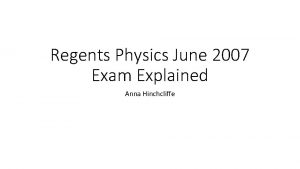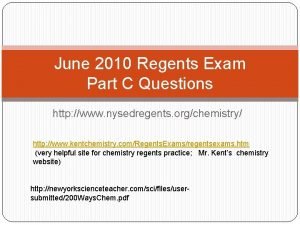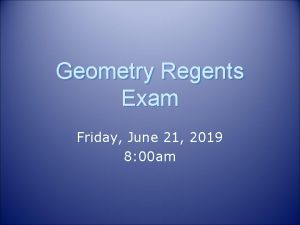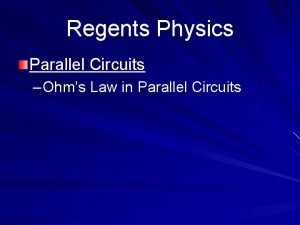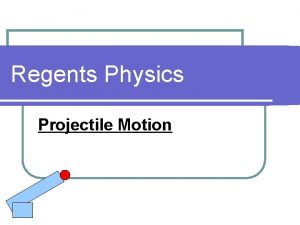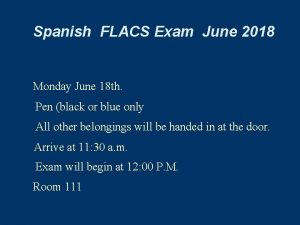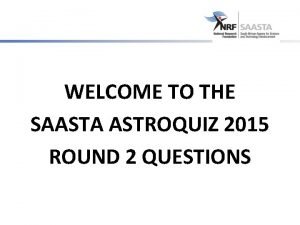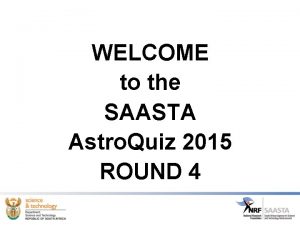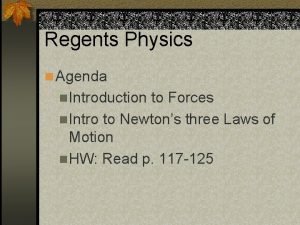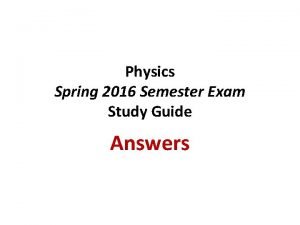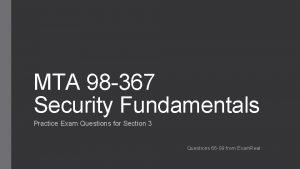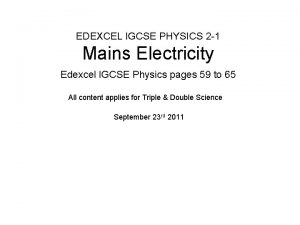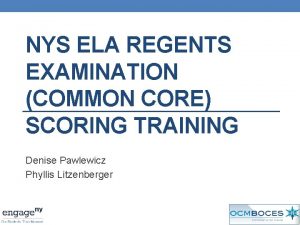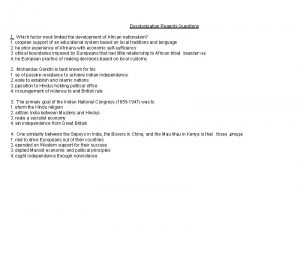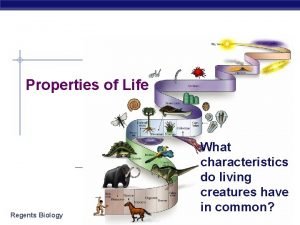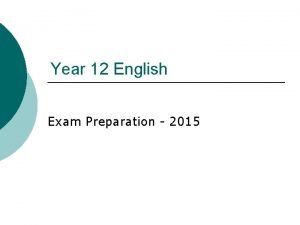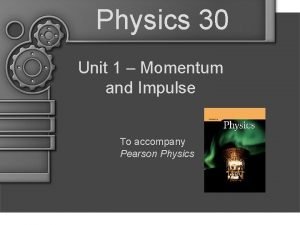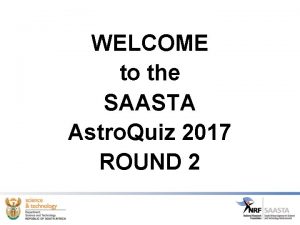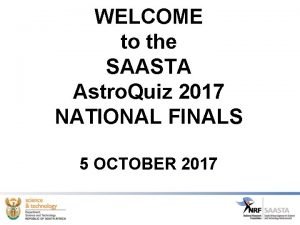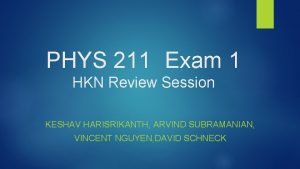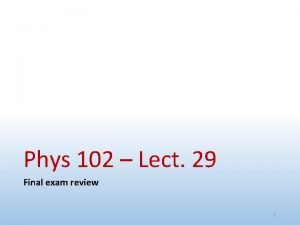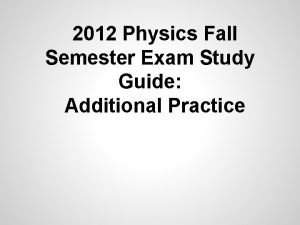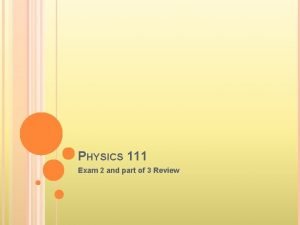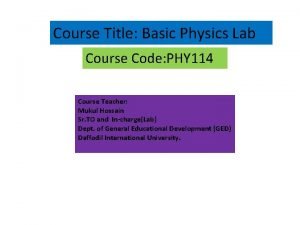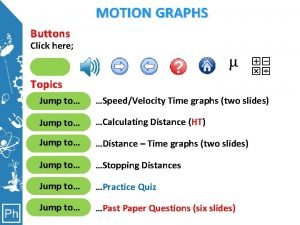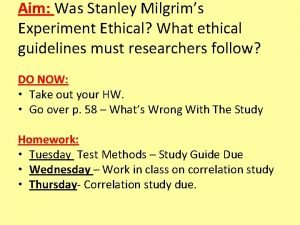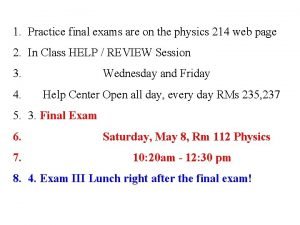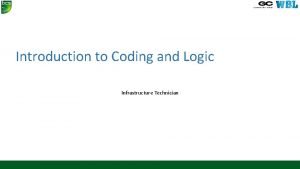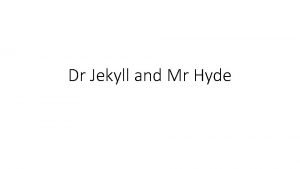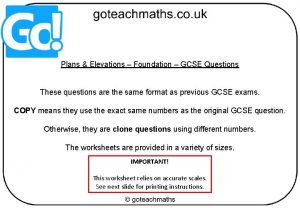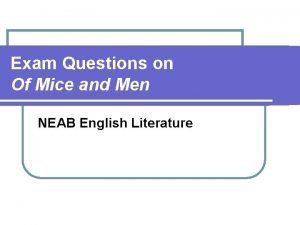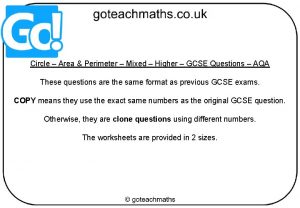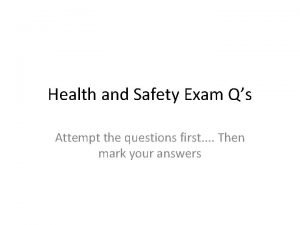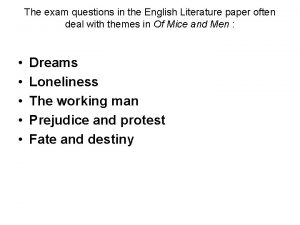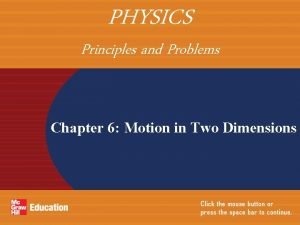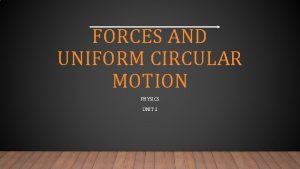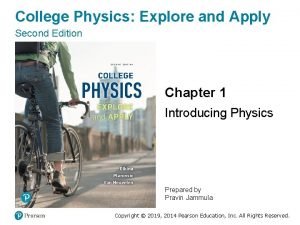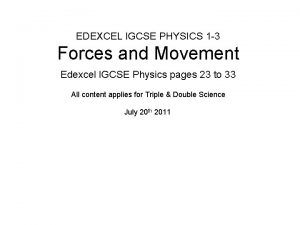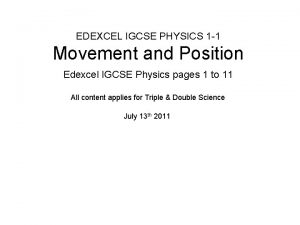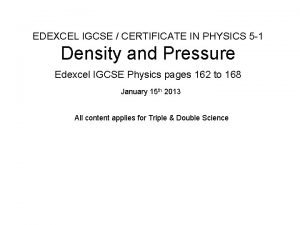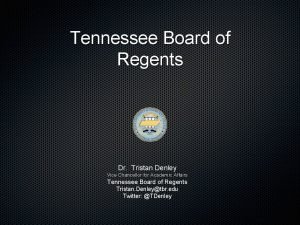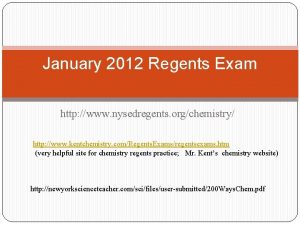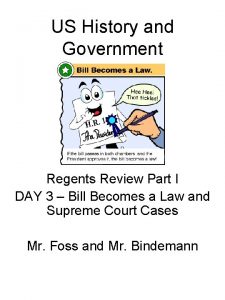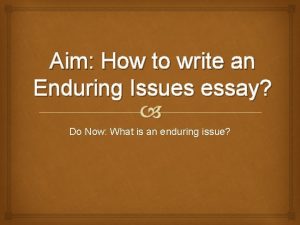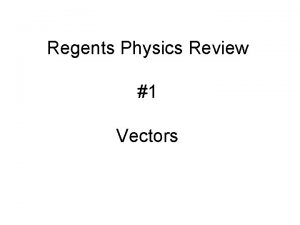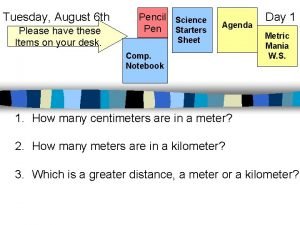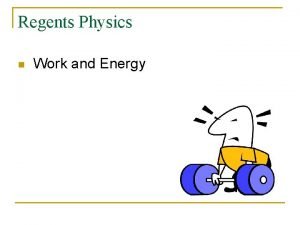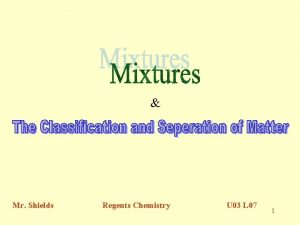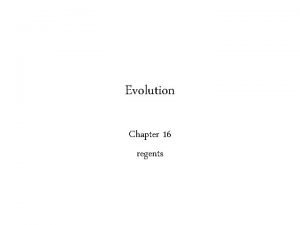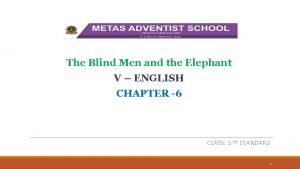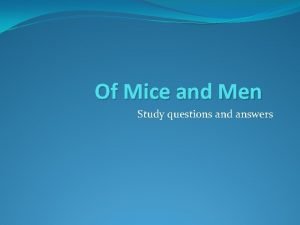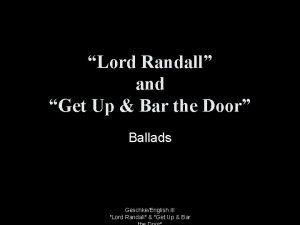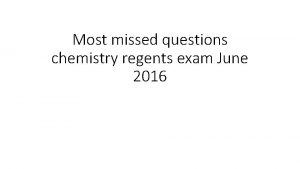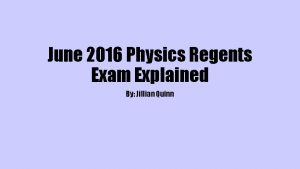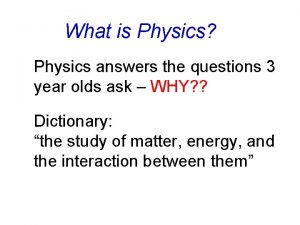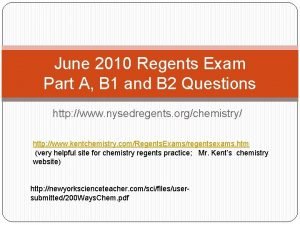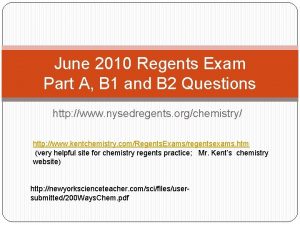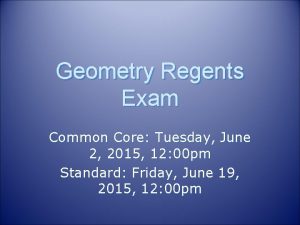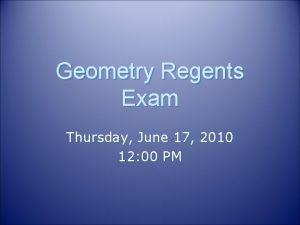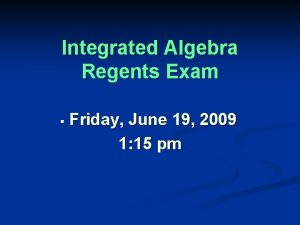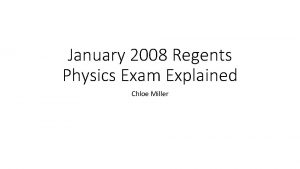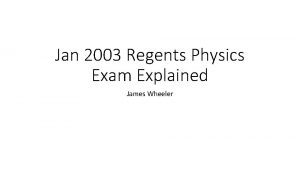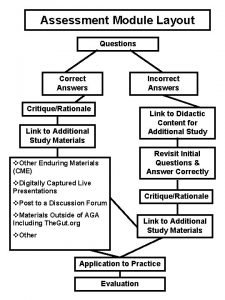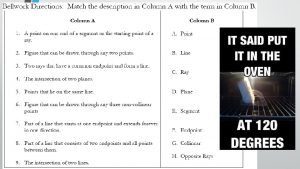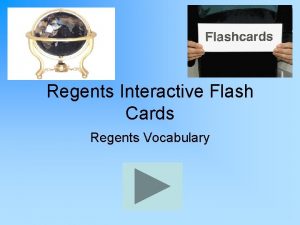June 2015 Regents Physics Exam Questions Answers and






























































































































- Slides: 126

June 2015 Regents Physics Exam Questions, Answers and Explanations By Angela La. Grou

1. ) Which quantities are scalar? (1) Speed and work (2) Velocity and force (3) Distance and acceleration (4) Momentum and power

Answer: (1) Speed and work Scalar quantities only have a magnitude, no direction.

2. ) A 3. 00 -kilogram mass is thrown vertically upward with an initial speed of 9. 80 meters per second. What is the maximum height this object will reach? [Neglect friction] (1) 1. 00 m (2) 4. 90 m (3) 9. 80 m (4) 19. 6 m

Answer: (2) 4. 90 m Steps: 1. ) List what you are given and what you are looking for 2. ) Using this list, decide which formula includes both the givens and what you are looking for. In this case, it is Vf 2 = Vi 2 + 2 ad 3. ) Manipulate formula to solve for distance 4. ) Plug in what you know and solve for distance

3. ) An airplane traveling north at 220. meters per second encounters a 50. 0 -meters-per-second crosswind from west to east, as represented in the diagram below. What is the resultant speed of the plane? (1) 170. m/s (2) 214 m/s (3) 226 m/s (4) 270 m/s

Answer: (3) 226 m/s • You can draw out a diagram if you’d like to help you picture what is happening. • Since the velocity north and the velocity east form a 90 -degree angle, you can use the Pythagorean Theorem to find the resultant speed.

4. ) A 160. -kilogram space vehicle is traveling along a strait line at a constant speed of 800. meters per second. The magnitude of the net force on the space vehicle is (1) 0 N (2) 1. 60 x 102 N (3) 8. 00 x 102 N (4) 1. 28 x 105 N

Answer: (1) 0 N •

5. ) A student throws a 5. 0 -newton ball straight up. What is the net force on the ball at its maximum height? (1) 0. 0 N (2) 5. 0 N, up (3) 5. 0 N, down (4) 9. 8 N, down

Answer: (3) 5. 0 N • The weight of the object is what is pulling down on it

6. ) A vertical spring has a spring constant of 100. N per meter. When an object is attached to the bottom of the spring, the spring changes from its unstretched length of 0. 50 meter to a length of 0. 65 meter. The magnitude of the weight of the attached object is (1) 1. 1 N (2) 15 N (3) 50 N (4) 65 N

Answer: (2) 15 N Steps: 1. ) List what you are given and what you are looking for. In this problem, the force on the spring (Fs ) is the weight of the object 2. ) x, which is the change in the spring length from the equilibrium position, came from subtracting. 5 meter from. 65 meter. 4. ) Plug in what you know and solve for Fs

7. ) A 1. 5 -kilogram cart initially moves at 2. 0 meters per second. It is brought to rest by a constant net force in 0. 3 second. What is the magnitude of the net force? (1) 0. 40 N (2) 0. 90 N (3) 10. N (4) 15 N

Answer: (3) 10 N •

8. ) Which characteristic of a light wave must increase as the light wave passes from glass into air? (1) Amplitude (2) Frequency (3) Period (4) Wavelength

Answer: (4) Wavelength The index of refraction of an object is how much the substance slows down the light wave that is passing through it. Since air has a lower absolute indices of refraction than glass, it can travel quicker. An increased velocity causes an increased wavelength

9. ) As a 5. 0 x 102 newton basketball player jumps from the floor up toward the basket, the magnitude of the force of her feet on the floor is 1. 0 x 103 newtons. As she jumps, the magnitude of the force of the floor on her feet is. (1) 5. 0 x 102 N (2) 1. 0 x 103 N (3) 1. 5 x 103 N (4) 5. 0 x 105 N

Answer: 1. 0 x 103 N According to Newton’s Third Law, very action has an equal and opposite reaction. Therefore the force that she exerts on the floor is equal to the force that the floor exerts back on her.

10. ) A 0. 0600 -kilogram ball traveling at 60. 0 meters per second hits a concrete wall. What speed must a 0. 0100 -kilogram bullet have in order to hit the wall with the same magnitude of momentum as the ball? (1) 3. 60 m/s (2) 6. 00 m/s (3) 360 m/s (4) 600 m/s

Answer: (3) 360 m/s Steps: 1. ) List what you are given and what you're looking for 2. ) The question states that the bullet and ball will have the same magnitude of momentum. Therefore, you can set PBall = PBullet 3. ) Since p=m x v, you can set the m x v of the ball to the m x v of the bullet 4. ) Manipulate the equation so that it is equal to VBullet 5. ) Plug in what you know and solve for the bullet’s velocity

11. ) The Hubble telescope’s orbit is 5. 6 x 10^5 meters above Earth’s surface. The telescope has a mass of 1. 1 x 10^4 kilograms. Earth exerts a gravitational force of 9. 1 x 10^4 newtons on the telescope. The magnitude of Earth’s gravitational field strength at this location is (1) 1. 5 x 10^-20 N/kg (2) 0. 12 N/kg (3) 8. 3 N/kg (4) 9. 8 N/kg

Answer: (3) 8. 3 N/kg Steps: 1. ) List what you are given and what you are looking for 2. ) Using this list, decide which formula includes both the givens and what you are looking for. In this case, it is g= Fg /m 3. ) Plug in what you know and solve for g.

12. ) When two point charges are a distant d apart, the magnitude of the electrostatic force between them is F. If the distance between the point charges is increased to 3 d, the magnitude of the electrostatic force between the two charges will be (1) 1/9 F (2) 1/3 F (3) 2 F (4) 4 F

Answer: (1) 1/9 F

13. ) A radio operating at 3. 0 volts and a constant temperature draws a current of 1. 8 x 10 -4 ampere. What is the resistance of the radio circuit? (1) 1. 7 x 104 ohms (2) 3. 0 x 101 ohms (3) 5. 4 x 10 -4 ohms (4) 6. 0 x 10 -5 ohms

Answer: (1) 1. 7 x 104 ohms Steps: 1. ) List out what you are given and what you are looking for 2. ) Using this list, decide which formula includes both the givens and what you are looking for. In this case, it is R=V/ I 3. ) Plug in what you know and solve for the resistance

14. ) Which energy transformation occurs in an operating electric motor? (1) Electrical Mechanical (2) Mechanical Electrical (3) Chemical Electrical (4) Electrical Chemical

Answer: (1) Electrical Mechanical An example of an electric motor is a fan. A fan takes in electricity from the electrical outlet and converts it into mechanical energy, which moves the blades

15. ) A block slides across a rough, horizontal tabletop. As the block comes to rest, there is an increase in the block-tabletop system’s (1) Gravitational potential energy (2) Elastic potential energy (3) Kinetic energy (4) Internal (thermal) energy

Answer: (4) Internal (thermal) energy When an object is moving it has kinetic energy, which is the energy of motion. When the block is stopped because of the friction, it wouldn’t make sense for the kinetic energy to increase. Neither the gravitational potential energy or the elastic potential energy would change because the object isn’t changing in height Therefore, the first 3 options are eliminated When the block is stopped because of friction, the kinetic energy is converted into thermal energy

16. ) How much work is required to move an electron through a potential difference of 3. 00 volts? (1) 5. 33 x 10 -20 J (2) 4. 80 x 10 -19 J (3) 3. 00 J (4) 1. 88 x 1019 J

Answer: (2) 4. 80 x 10 -19 J Steps: 1. ) List what you are given and what you are looking for. You can find the charge of an electron on the first page of the reference table 2. ) Pick an equation that includes both what you are given and what you are looking for 3. ) Manipulate the equation so that it is solving for W 4. ) Plug the values in and solve for work

17. ) During a laboratory experiment, a student finds that 20 degrees Celsius, a 6. 0 -meter length of copper wire has a resistance of 1. 3 ohms. The cross-sectional area of this wire is (1) 7. 9 x 10 -8 m 2 (2) 1. 1 x 10 -7 m 2 (3) 4. 6 x 100 m 2 (4) 1. 3 x 107 m 2

Answer: (1) 7. 9 x 10 -8 m 2 Steps: 1. ) List what you are given and what you are looking for. You can find the resistivity of copper on page 4 of the reference table 2. ) Pick an equation that includes both what you are given and what you are looking for 3. ) Manipulate the equation so that you are solving for A (cross-sectional area) 4. ) Plug in what you know and solve for A

18. ) A net charge of 5. 0 coulombs passes a point on a conductor in 0. 050 second. The average current is (1) 8. 0 x 10 -8 A (2) 1. 0 x 10 -2 A (3) 2. 5 x 10 -1 A (4) 1. 0 x 102 A

Answer: (4) 1. 0 x 102 A Steps: 1. ) List what you are given and what you are looking for 2. ) Pick an equation that includes these things 3. ) Plug in the values and solve for I (current)

19. ) If several resistors are connected in series in an electric circuit, the potential difference across each resistor (1) Varies directly with its resistance (2) Varies inversely with its resistance (3) Varies inversely with the square of its resistance (4) Is independent of its resistance

Answer: (1) Varies directly with its resistance This relationship can be seen using the equation R=V/I • If the potential difference is increased, the resistance increases to keep the equation balanced • If the potential difference is increased, the resistance decreases to keep the equation balanced (Assuming the current stays constant)

20. ) The amplitude of a sound wave is most closely related to the sound’s (1) speed (2) wavelength (3) loudness (4) pitch

Answer: (3) Loudness The amplitude of a sound wave determines how loud it is. The greater the amplitude, the louder the sound.

21. ) A duck floating on a lake oscillates up and down 5. 0 times during a 10. -second interval as a periodic wave passes by. What is the frequency of the duck’s oscillations? (1) 0. 10 Hz (2) 0. 50 Hz (3) 2. 0 Hz (4) 50. Hz

Answer: (2) 0. 50 Hz The frequency is the number of waves that pass by in a certain amount of time. In this case, finding the frequency is asking for how many times the duck oscillates up and down per one second

22. ) Which diagram best represents the position of a ball, at equal time intervals, as it falls freely from rest near Earth’s surface?

Answer: (2) When something falls, it falls further and further per second as time increases because of the acceleration due to gravity • This can be seen by using the equation: Since the ball just falls and is not thrown, the initial velocity is zero.

23. ) A gamma ray and a microwave traveling in a vacuum have the same (1)Frequency (2)Period (3)Speed (4)Wavelength

Answer: (3) Speed All electromagnetic waves moving through a vacuum travel at a speed of 3. 00 x 108 m/s • This value is in the List of Physical Constants on the first page in the reference tables.

24. ) A student produces a wave in a long spring by vibrating its end. As the frequency of the vibration is doubled, the wavelength in the spring is (1) Quartered (2) Halved (3) Unchanged (4) Doubled

Answer: (2) Halved This equation represents the relationship between wavelength and frequency. Since they are on the same side of the equation, if the frequency is doubled, the wavelength would have to be halved in order to keep the sides equal.

25. ) Which two points on the wave shown in the diagram below are in phase with each other? (1) A and B (2) A and E (3) B and C (4) B and D

Answer: (4) B and D • Points that are in phase are on the same part of the wave • In this image, points B and D are both on the part of the wave that is going down

26. ) As a longitudinal wave moves through a medium, the particles of the medium (1) Vibrate parallel to the direction of the wave’s propagation (2) Vibrate perpendicular to the direction of the wave’s propagation (3) Are transferred in the direction of the wave’s motion, only (4) Are stationary

Answer: (1) Vibrate parallel to the direction of the wave’s propagation • Particles of longitudinal waves vibrate in the same direction as the wave's velocity

27. ) Wind blowing across suspended power lines may cause the power lines to vibrate at their natural frequency. This often produces audible sound waves. This phenomenon, often called an Aeolian harp, is an example of (1) Diffraction (2) The Doppler effect (3) Refraction (4) Resonance

Answer: (4) Resonance is one object emitting a sound wave with a specific frequency causing another object to vibrate with the same frequency.

28. ) A student listens to music from a speaker in an adjoining room, as represented in the diagram below. She notices that she does not have to be directly in front of the doorway to hear the music. This spreading of sound waves beyond the doorway is an example of (1) The Doppler effect (2) Resonance (3) Refraction (4) Diffraction

Answer: (4) Diffraction The definition of diffraction is the bending of waves around obstacles; the spreading of waves as they pass through an opening

29. ) What is the minimum energy required to ionize a hydrogen atom in the n=3 state? (1) 0. 00 e. V (2) 0. 66 e. V (3) 1. 52 e. V (4) 12. 09 e. V

Answer: 1. 52 e. V

30. ) The diagram represents two small, charged, identical metal spheres, A and B that are separated by a distance of 2. 0 meters. What is the magnitude of the electrostatic force exerted by sphere A on sphere B? (1) 7. 2 x 10 -3 N (2) 3. 6 x 10 -3 N (3) 8. 0 x 10 -13 N (4) 4. 0 x 10 -13 N

Answer: (2) 3. 6 x 10 -3 N Steps: 1. ) List what you are given and what you are looking for • 2. ) Decide which formula includes both the givens and what you are looking for. This is Fe = Kq 1 q 2 r 2 • Plug in what you know and solve for Fe. You can find the value for k (electrostatic constant) on the first page of the reference table

31. ) If the two spheres were touched together and then separated, the charge on sphere A would be (1) -3. 0 x 10 -7 C (2) -6. 0 x 10 -7 C (3) -1. 3 x 10 -6 C (4) -2. 6 x 10 -6 C

Answer: (1) -3. 0 x 10 -7 C When two spheres are brought together, their charges get added up. When they are separated, they do not go back to the original charge. Their new charge is the combined charge divided by 2

32. ) The horn of a moving vehicle produces a sound of constant frequency. Two stationary observers, A and C, and the vehicle’s driver, B, positioned as represented in the diagram below, hear the sound of the horn. Compared to the frequency of the sound of the horn heard by driver B, the frequency heard by observer A is (1) Lower and the frequency heard by observer C is lower (2) Lower and the frequency heard by observer C is higher (3) Higher and the frequency heard by observer C is lower (4) Higher and the frequency heard by observer C is higher

Answer: (2) Lower and the frequency heard by observer C is higher This change in frequency is caused by the Doppler Effect • Motion toward each other = observer hears higher frequency • Motion away from each other = observer hears lower frequency

33. ) A different force is applied to each of four different blocks on a frictionless, horizontal surface. In which diagram does the block have the greatest inertia 2. 0 seconds after starting from rest?

Answer: (4) • Inertia is directly proportional to mass. The more mass an object has, the more inertia it has. The block in choice 4 has the most mass

34. ) The diagram below shows a ray of monochromatic light incident on a boundary between air and glass. Which ray best represents the path of the reflected light ray? (1) A (2) B (3) C (4) D

Answer: (1) A According to the Law of Reflection, the angle of incidence is equal to the angle of reflection

35. ) Two pulses approach each other in the same medium. The diagram below represents the displacements caused by each pulse. Which diagram best represents the resultant displacement of the medium as the pulses pass through each other?

Answer: (2) When pulses pass each other, they combine and form a mix of the two shapes =

36. ) The diameter of an automobile tire is closest to

Answer: (2) 100 m 100 Is equal to 1 meter, which is close to the size of a tire, when compared to the other options that are equal to 10 m, 100 m, and 1 cm

37. ) The vector diagram below represents the velocity of a car traveling 24 meters per second 35 degrees east of north What is the magnitude of the component of the car’s velocity that is directed eastward? (1) 14 m/s (2) 20 m/s (3) 29 m/s (4) 42 m/s

Answer: (1) 14 m/s With the scale of 1 cm = 1 m/s, you can use a ruler to find the eastward component. • The vector (with the ruler positioned that way) is 24 cm, which represents the velocity. If you draw a line down at a 90 degree angle, you can see many cm the eastward component is 1 cm = 1 m/s

38. ) Without air resistance, a kicked ball would reach a maximum height of 6. 7 meters and land 38 meters away. With air resistance, the ball would travel (1) 6. 7 m vertically and more than 38 m horizontally (2) 38 m horizontally and less than 6. 7 m horizontally (3) More than 6. 7 m vertically and less than 38 m horizontally (4) Less than 38 m horizontally and less than 6. 7 m vertically

Answer: (4) Less than 38 m horizontally and less than 6. 7 m vertically Air resistance is an opposing force; therefore it would act in the opposite direction that the ball is heading, which would cause it to travel a shorter distance.

39. ) A car is moving with a constant speed of 20 meters per second. What total distance does the car travel in 2. 0 minutes? (1) 10 m (2) 40 m (3) 1200 m (4) 2400 m

Answer: (4) 2400 m Steps: 1. ) List out what you are given and what you are looking for 2. ) Manipulate the equation so you are solving for distance 3. ) Plug in what you know and solve for d

40. ) A car, initially traveling at 15 meters per second north, accelerates to 25 meters per second north in 4. 0 seconds. The magnitude of the average acceleration is (1) 2. 5 m/s 2 (2) 6. 3 m/s 2 (3) 10 m/s 2 (4) 20 m/s 2

Answer: (1) 2. 5 m/s 2 Steps: 1. ) List out what you know and what you are looking for 2. ) Pick a formula that includes all of these 3. ) Solve for acceleration

41. ) An object is in equilibrium. Which force vector diagram could represent the force(s) acting on the object?

Answer: (4) When an object is in equilibrium, all of the forces on the object balance out to equal zero. You could think of this diagram as 3 people pulling a rope that is connected to something in the center. The object would not move

42. ) Which combination of fundamental units can be used to express the amount of work done on an object?

Answer: (3)

43. ) Which graph best represents the relationship between the potential energy stored in a spring and the change in the spring’s length from its equilibrium position?

Answer: (1) Using this equation from the reference table, you can see the relationship between the spring’s potential energy (PES ) and the change in the spring’s length from its equilibrium position (x). As the PES increases, the x must increase in order for the sides of the equation to remain equal to each other. Since the x is squared, the graph would look exponential and not linear.

44. ) An electric motor has a rating of 4. 0 x 102 watts. How much time will it take for this motor to lift a 50. -kilogram mass a vertical distance of 8. 0 meters? [Assume 100% efficiency] (1)0. 98 s (2)9. 8 s (3)98 s (4)980 s

Answer: (2) 9. 8 seconds Steps: 1. ) List out what you are given and what you are looking for 2. ) Although there isn’t a specific equation in the reference table that includes these variables, you can manipulate other equations in order to make one that has what you need it to 3. ) We know W=Fd, and we also know that W=Pt. Since they both equal W, you can set these equal to each other. You now have an equation that includes what you are given and what you are looking for. 4. ) Plug in what you know and solve for t

45. ) A compressed spring in a toy is used to launch a 5. 00 gram ball. If the ball leaves the toy with an initial horizontal speed of 5. 00 meters per second, the minimum amount of potential energy stored in the compressed spring was (1) 0. 0125 J (2) 0. 0250 J (3) 0. 0625 J (4) 0. 125 J

Answer: (3) 0. 0625 J Steps: 1. ) List what you are given and what you are looking for 2. ) Convert 5 grams into kg 3. ) The energy is converted from KE to PE, so to solve for the PE you can use KE= ½ mv 2 4. ) Plug in what you know and solve for KE

46. ) A ray of yellow light (f = 5. 09 x 1014 Hz) travels at a speed of 2. 04 x 108 meters per second in (1) Ethyl alcohol (2) Water (3) Lucite (4) Glycerol

Answer: (4) Glycerol Steps: 1. ) List what you are given and what you are looking for. You can find the value for c on the first page of the reference table 2. ) Using the equation n=c/v, solve for n (this value is the absolute indices of refraction for a substance) 3. ) The value 1. 47 is the absolute indices of refraction for Glycerol (found on pg. 2 of the reference tables)

47. ) A blue-light photon has a wavelength of 4. 80 x 10 -7 meter. What is the energy of the photon?

Answer: (3) • List out what you know and what you are looking for • Choose an equation that has both things • You can find Planck’s Constant (h) and the speed of light in a vacuum (c) on the first page of the reference tables

48. ) The graph below represents the relationship between the force exerted on an elevator and the distance the elevator is lifted. How much total work is done by the force in lifting the elevator from 0. 0 m to 9. 0 m ?

Answer: (3) Work is the area underneath a force-distance graph

49. ) The diagram below shows waves A and B in the same medium. Compared to wave A, wave B has (1) Twice the amplitude and twice the wavelength (2) Twice the amplitude and half the wavelength (3) The same amplitude and half the wavelength (4) Half the amplitude and the same wavelength

Answer: (2) Twice the amplitude and half the wavelength Amplitude is the top position on the wavelength to its rest position (in yellow). You can see that B has twice the amplitude. Wavelength is the distance between two identical points on the wave (in purple). You can see that B has half the wavelength.

50. ) What is the quark composition of a proton? (1) uud (2) udd (3) csb (4) uds

Answer: (1) uud • On page 3 of the reference table, you can find Particles of the Standard Model. • Each quark has an associated charge • The combination of each quark charge should add to +1 (charge of a proton) Option 1, uud, is the only option that adds to +1

51 -52. ) Calculate the minimum power output of an electric motor that lifts a 1. 30 x 1014 newton elevator car vertically upward at a constant speed of 1. 50 meters per second. • Since W=Fd and W=Pt, you can set them equal to each other • We do not know the value for d, but we do know the velocity. Using the equation V=d/t, we can find that d=vt. • Plug vt in for d. Since there is a t on both sides of the equation, it can be crossed out • Using the formula P=Fv that you just found, plug in the values and solve for P

53 -54. ) A microwave oven emits a microwave with a wavelength of 2. 00 x 10 -2 meter in air. Calculate the frequency of the microwave Steps: 1. ) Find a formula in the reference table that includes what you are given and what you are looking for. 2. ) Manipulate the formula so it is equal to f 3. ) Plug in the speed of light from the reference table for v (3. 00 x 108 m/s) and plug in the wavelength (2. 00 x 10 -2 m)

55 -56. ) Calculate the energy equivalent in joules of the mass of a proton. • On the first page of the reference table, you can find that the mass of a proton is 1. 67 x 10 -27 kg. • C, which is the speed of light in a vacuum, is 3. 00 x 108 • The symbol of total energy is E

57. ) On the diagram in your answer booklet, draw an arrow to indicate the direction of the velocity of the car when it is at the position shown. Start the arrow on the car. The object is moving tangent to the circle; therefore the velocity vector is also tangent to the circle, and is pointed in the direction of the car’s motion

58 -59. ) Calculate the magnitude of the centripetal acceleration of the car.

60. ) A football is thrown at an angle of 30 degrees above the horizontal. The magnitude of the horizontal component of the ball’s velocity is 13. 0 meters per second. The magnitude of the vertical component of the ball’s initial velocity is 7. 5 meters per second. On the axes in your answer booklet, draw a graph representing the relationship between the horizontal displacement of the football and the time the football is in the air. As the time increases that the football is in the air, the distance it travels also increases

61 -62. ) The football is caught at the same height from which is thrown. Calculate the total time the football was in the air. When the football is caught, its velocity is zero You don’t want the t on both sides, so plug in v for d/t **There is more than one way to solve this, this is just one of the options

63. ) Use a protractor to determine the angle of refraction of the light ray as it passes from the unknown material into air. 56 degrees

64 -65. ) Calculate the index of refraction of the unknown material •

66. ) The diagram below represents a 4. 0 -newton force applied to a 0. 200 - kilogram copper block sliding to the right on a horizontal steel table. Determine the weight of the block Steps: 1. ) List out what you are given and what you are looking for 2. ) Find an equation that includes both the givens and what you are looking for. This is w=mg 3. ) Solve for w

67 -68. ) Calculate the magnitude of the force of friction acting on the moving block Steps: 1. ) List what you are given and what you are looking for 2. ) Using this list, decide which formula includes both the givens and what you are looking for 3. ) You can find the coefficient of friction of copper on steel on the first page of the reference tables 4. ) The normal force is what is pulling down on the object. Therefore, you can plug in the weight of the object for the normal force 5. ) Plug in what you know and solve for the force of friction

69. ) Determine the magnitude of the net force acting on the moving block 1. ) Draw a free body diagram that represents all the forces that are acting on the box 2. ) The weight pulling down and the normal force pulling up balance each other out 3. ) Since there is 4 N pulling to the right and only. 71 N pulling to the left, you can subtract them and find that the net force is 3. 3 N

70. ) Describe what happens to the magnitude of the velocity of the block as the block slides across the table Since the force pulling to the right is greater than the force of friction… The magnitude of the velocity increases

71. ) On the diagram in your answer booklet, draw at least three field lines to represent the direction of the electric field in the space between the charged plates. • Electric field lines point away from positive charges and toward negative charges • Since the plates are parallel, the lines should be equidistant • Make sure they touch the plates

72. ) Identify the direction of the electrostatic force that the electric field exerts on the electron The electric field exerts an electrostatic force in the opposite direction of the field. Therefore, it is exerted toward the positive plate

73 -74. ) Calculate the magnitude of the electric field strength between the plates, in newtons per coulomb Steps: 1. ) List what you know and what you are looking for 2. ) You can find the value of an elementary charge on the first page of the reference table. This is 1. 60 x 10 -19 C 3. ) Plug in what you know and solve for E

75. ) Describe what happens to the magnitude of the net electrostatic force on the electron as the electron is moved toward the positive plate • It will not be effected by this The force will remain the same

76. ) Determine the letter that identifies the energy level to which the electron jumped when the mercury atom absorbed the photon (This is on page 3 of the reference tables)

77. ) Determine the energy of the photon, in joules You can find that 1 e. V = 1. 60 x 10 -19 J on the first page of the reference tables. Since the photon has 3. 06 e. V, multiply the value in joules by 3. 06

78 -79. ) Calculate the frequency of the photon • Use the value that you found in the previous question for the photon’s energy • Planck’s constant can be found on the first page of the reference tables

80. ) Classify the photon as one of the types of electromagnetic radiation listed in the electromagnetic spectrum Using Page 2 of the reference tables, you can see that the value for the frequency of violet light is the closest to the frequency that we found in the previous question

81 -82. ) Calculate the resistance of the 40. -watt lamp • (Pt 1) In order to find the resistance, you first need to find the current • You can do this by using the equation P=VI • (Pt 2) After you find the current, you can plug it into the equation R=V/I and find the resistance

83. ) Describe what change, if any, would occur in the power dissipated by the 100. -watt lamp if the 60. -watt lamp were to burn out No change would occur The power depends on the current and the potential difference

84. ) Describe what change, if any, would occur in the equivalent resistance of the circuit if the 60. watt lamp were to burn out The equivalent resistance would increase

85. ) The circuit is disassembled. The same three lamps are then connected in series with each other and the source. Compare the equivalent resistance of this series circuit to the equivalent resistance of the parallel circuit. The equivalent resistance of the series circuit would be greater than the equivalent resistance of the parallel circuit
 June 2007 physics regents answers
June 2007 physics regents answers Flacs checkpoint b spanish exam june 2017 answers
Flacs checkpoint b spanish exam june 2017 answers June 2010 chemistry regents answers
June 2010 chemistry regents answers June 21 2019 geometry regents answers
June 21 2019 geometry regents answers Nysedregents
Nysedregents January 2016 chemistry regents answers
January 2016 chemistry regents answers Ohm's law worksheet regents physics answer key
Ohm's law worksheet regents physics answer key Regents physics projectile motion questions
Regents physics projectile motion questions Flacs exam
Flacs exam Spanish flacs exam practice
Spanish flacs exam practice Pictograms can be easily identified because they have a
Pictograms can be easily identified because they have a Astro quiz round 2
Astro quiz round 2 Saasta astro quiz 2015 answers
Saasta astro quiz 2015 answers Regents physics work power energy
Regents physics work power energy Work and energy
Work and energy Physics regents
Physics regents Physics semester 1 final exam study guide answers
Physics semester 1 final exam study guide answers Grade 7 life orientation test
Grade 7 life orientation test Security fundamentals practice test
Security fundamentals practice test Recruitment and selection question paper
Recruitment and selection question paper Security architecture for systems engineer sase 500 651
Security architecture for systems engineer sase 500 651 ____________is used to give the tab space in vb.net.
____________is used to give the tab space in vb.net. Cobit 2019 exam questions
Cobit 2019 exam questions Ib physics topic 5 questions
Ib physics topic 5 questions Circuit breaker igcse
Circuit breaker igcse Nys ela regents argument rubric
Nys ela regents argument rubric Regents chemistry solutions practice problems
Regents chemistry solutions practice problems What were two indirect results of the crusades
What were two indirect results of the crusades Which title best completes this graphic organizer? *
Which title best completes this graphic organizer? * Decolonization regents questions
Decolonization regents questions Regents chemistry bonding questions
Regents chemistry bonding questions Characteristics of life regents questions
Characteristics of life regents questions Endocrine system regents questions
Endocrine system regents questions Endocrine system regents questions
Endocrine system regents questions 2015 vcaa english exam
2015 vcaa english exam Hsc hospitality exam
Hsc hospitality exam Physics 30 momentum and impulse unit exam
Physics 30 momentum and impulse unit exam Write questions for the following answers
Write questions for the following answers Whmis hazard categories 1-4
Whmis hazard categories 1-4 Chemsheets calorimetry 3 answers
Chemsheets calorimetry 3 answers Saasta astro quiz 2017 round 1 answers
Saasta astro quiz 2017 round 1 answers Astro quiz 2019 questions and answers
Astro quiz 2019 questions and answers Oxford university press 2019 answers
Oxford university press 2019 answers Physics 211 exam 1
Physics 211 exam 1 Physics fall final exam review
Physics fall final exam review Physics 102 final exam
Physics 102 final exam Physics fall semester review answers
Physics fall semester review answers Physics 1 exam 2 review
Physics 1 exam 2 review Physics exam 2 review
Physics exam 2 review Physics 111 exam 2
Physics 111 exam 2 Diu blc
Diu blc Click graph
Click graph Milgrim experiment
Milgrim experiment Physics 101 final exam
Physics 101 final exam 2015 dse
2015 dse Regents biology food chains and energy in ecosystems
Regents biology food chains and energy in ecosystems Us history regents essay
Us history regents essay Coding and logic exam questions
Coding and logic exam questions Modern physics vs classical physics
Modern physics vs classical physics University physics with modern physics fifteenth edition
University physics with modern physics fifteenth edition Ib physics hl ia ideas
Ib physics hl ia ideas Global governance questions
Global governance questions Jekyll and hyde exam questions
Jekyll and hyde exam questions Plans and elevations exam questions
Plans and elevations exam questions Gcse history past papers edexcel
Gcse history past papers edexcel Stem and leaf exam questions
Stem and leaf exam questions Of mice and men exam questions
Of mice and men exam questions Area and perimeter gcse exam questions higher
Area and perimeter gcse exam questions higher Health and safety exam questions
Health and safety exam questions Of_mice_and_men study guide answer key (1)
Of_mice_and_men study guide answer key (1) Physics principles and problems chapter 6 answers
Physics principles and problems chapter 6 answers Physics 02-02 weight and gravity answers
Physics 02-02 weight and gravity answers College physics: explore and apply solutions
College physics: explore and apply solutions 30 days has september april june and november
30 days has september april june and november February march april may june july august september
February march april may june july august september Forces and motion igcse
Forces and motion igcse Movement and position
Movement and position Density of mercury in kg/m3
Density of mercury in kg/m3 Us history regents review
Us history regents review Which map shows the most probable areas of precipitation
Which map shows the most probable areas of precipitation Compared to atoms of metals, atoms of nonmetals generally
Compared to atoms of metals, atoms of nonmetals generally Tristan denley louisiana board of regents
Tristan denley louisiana board of regents The beaks of finches student laboratory packet
The beaks of finches student laboratory packet Lab practical review earth science
Lab practical review earth science Chemistry regents 2011
Chemistry regents 2011 Moles conversion chart
Moles conversion chart Louisiana board of regents
Louisiana board of regents Earth science reference table page 8 and 9
Earth science reference table page 8 and 9 Earth science lab practical
Earth science lab practical Nysedregents chemistry
Nysedregents chemistry Regents policy 5402
Regents policy 5402 Crq global regents
Crq global regents 282 ways to pass the earth science regents
282 ways to pass the earth science regents American history regents review
American history regents review Global regents thematic essay topics
Global regents thematic essay topics Regents solubility table
Regents solubility table Regents chemistry midterm
Regents chemistry midterm Enduring issue essay example
Enduring issue essay example The diagram below represents a 155 newton box on a ramp
The diagram below represents a 155 newton box on a ramp Comprehensive english regents
Comprehensive english regents La board of regents
La board of regents Dhhdnf
Dhhdnf Global 9 regents
Global 9 regents Ccela
Ccela Regents
Regents How to write an enduring issues essay
How to write an enduring issues essay Evison regents
Evison regents Metric mania lesson 3: volume answer key
Metric mania lesson 3: volume answer key Regents
Regents Regents of university of california v bakke
Regents of university of california v bakke Paper chromatography is a method used in regents
Paper chromatography is a method used in regents Regents
Regents Rocks clusters
Rocks clusters Regents
Regents Evison regents
Evison regents Regents mind maps
Regents mind maps Regents professor emeritus
Regents professor emeritus How does nick describe the guests at gatsby's party
How does nick describe the guests at gatsby's party The giver chapter 3 quiz
The giver chapter 3 quiz The blind man and the elephant question answers
The blind man and the elephant question answers Of mice and men study questions
Of mice and men study questions What was the conflict
What was the conflict Look at the photos and answer the questions what aspects
Look at the photos and answer the questions what aspects Daniel chapter 4 questions and answers
Daniel chapter 4 questions and answers Bridge to terabithia chapter questions
Bridge to terabithia chapter questions Questions for animal farm
Questions for animal farm Willow and ginkgo poem questions and answers
Willow and ginkgo poem questions and answers
